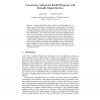Free Online Productivity Tools
i2Speak
i2Symbol
i2OCR
iTex2Img
iWeb2Print
iWeb2Shot
i2Type
iPdf2Split
iPdf2Merge
i2Bopomofo
i2Arabic
i2Style
i2Image
i2PDF
iLatex2Rtf
Sci2ools
LCPC
2005
Springer
2005
Springer
Concurrency Analysis for Parallel Programs with Textually Aligned Barriers
Abstract. A fundamental problem in the analysis of parallel programs is to determine when two statements in a program may run concurrently. This analysis is the parallel analog to control flow analysis on serial programs and is useful in detecting parallel programming errors and as a precursor to semantics-preserving code transformations. We consider the problem of analyzing parallel programs that access shared memory and use barrier synchronization, specifically those with textually aligned barriers and single-valued expressions. We present an intermediate graph representation for parallel programs and an efficient interprocedural analysis algorithm that conservatively computes the set of all concurrent statements. We improve the precision of this algorithm by using context-free language reachability to ignore infeasible program paths. We then apply the algorithms to static race detection and show that it can benefit from the concurrency information provided.
| Added | 28 Jun 2010 |
| Updated | 28 Jun 2010 |
| Type | Conference |
| Year | 2005 |
| Where | LCPC |
| Authors | Amir Kamil, Katherine A. Yelick |
Comments (0)

